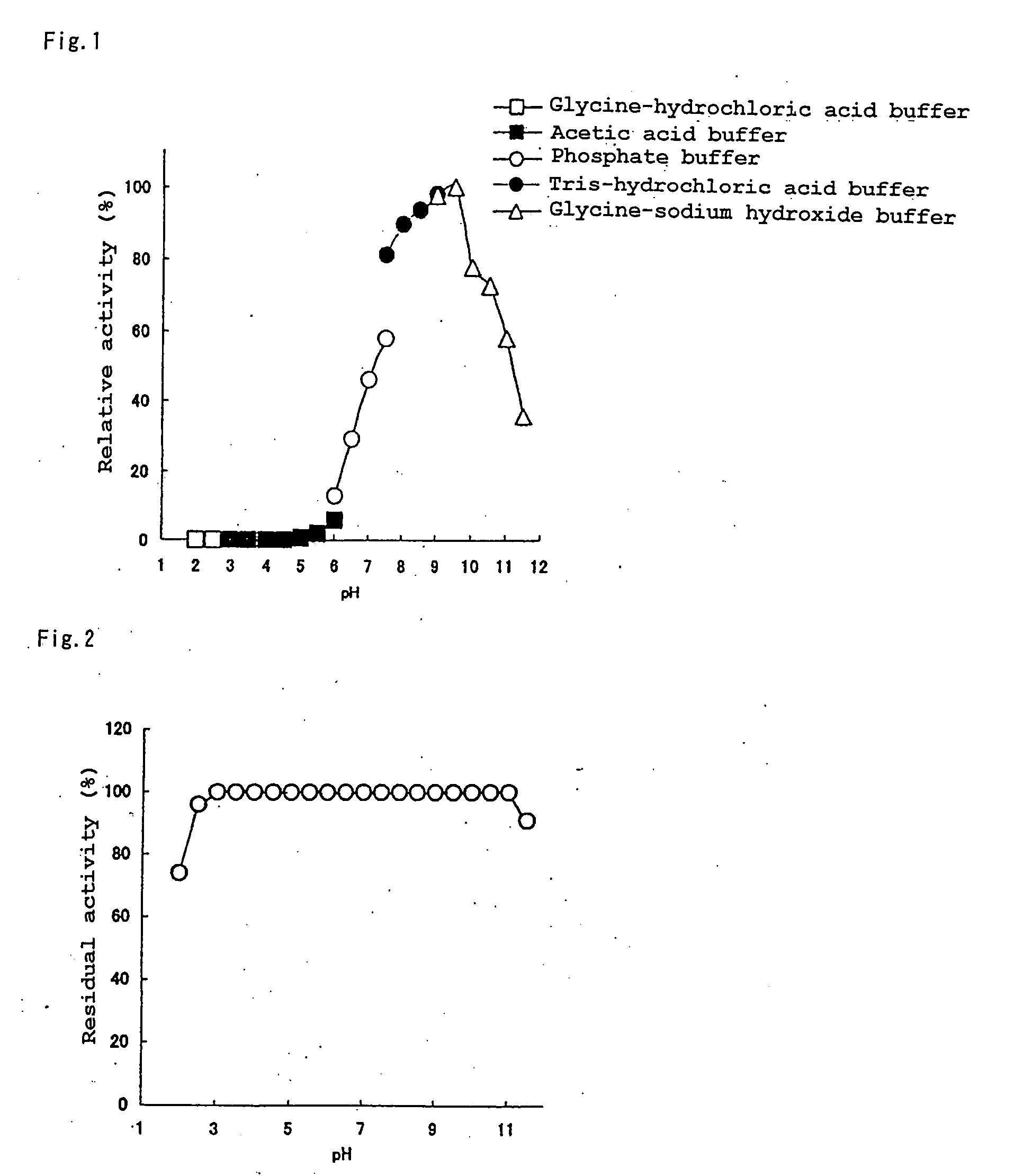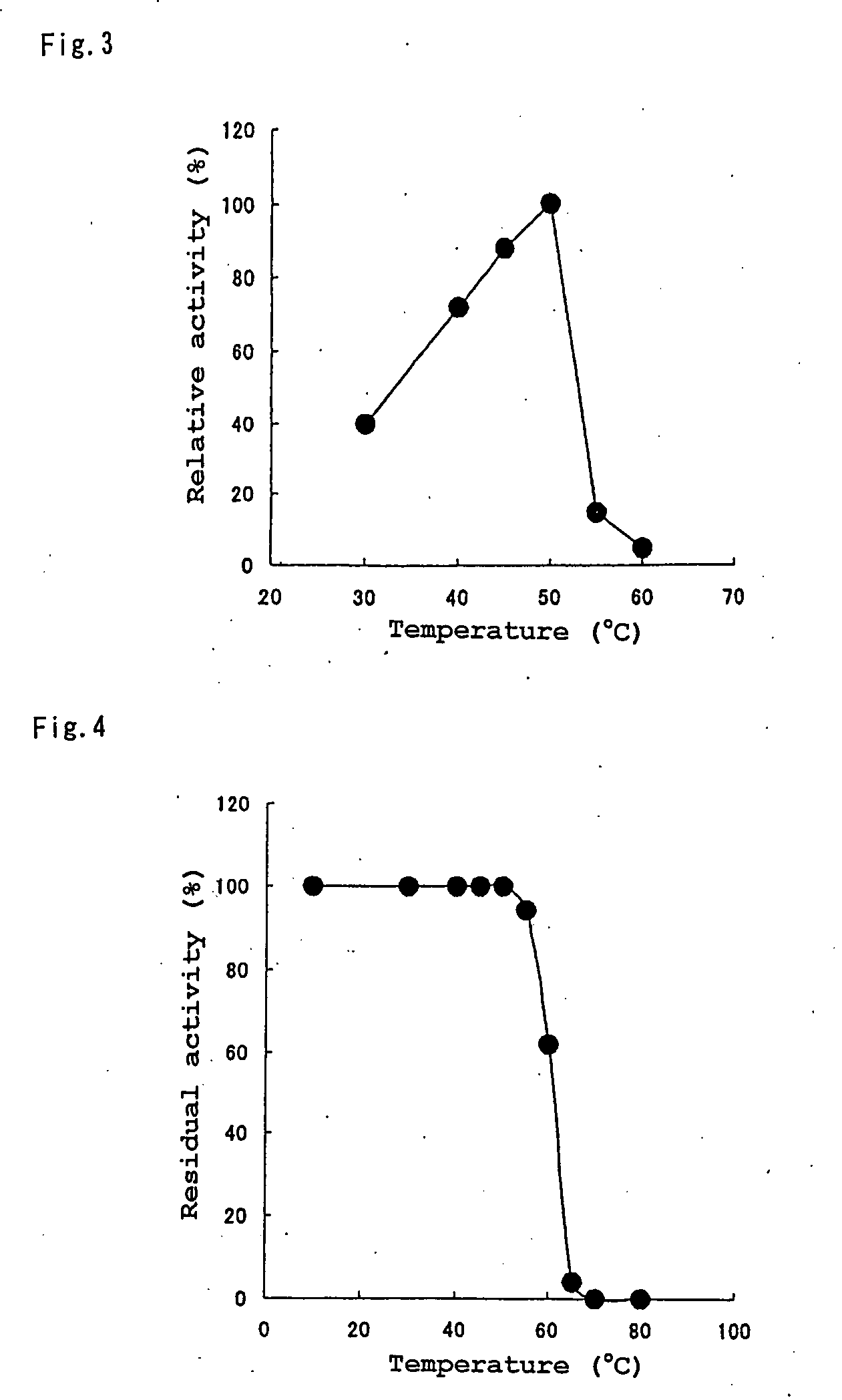Novel Protease, Microorganism Producing the Same, and Application Thereof
a technology of protease and microorganism, applied in the field of new protease and microorganism producing the same, can solve the problems that none of the known proteases used in the fields of medicines and foods is stable in a wide ph, and achieves excellent thrombolytic activity and useful physiological activity
- Summary
- Abstract
- Description
- Claims
- Application Information
AI Technical Summary
Benefits of technology
Problems solved by technology
Method used
Image
Examples
example 1
Production of Protease
[0116]One platinum loop of Fusarium sp. strain BLB (FERM BP-10493) isolated from tempeh prepared using hibiscus leaves was inoculated into 30 ml of liquid medium (containing 2 wt. % of defatted soybean powder, 2 wt. % of glucose, 0.5% of polypeptone, 0.2 wt. % of yeast extract, 0.1 wt. % of KH2PO4, and 0.05 wt. % of MgSO4), and shaking culture was carried out at 28° C. for 72 hours to give a preculture medium. Subsequently, 15 ml of preculture medium was inoculated into 1.5 l of liquid medium (containing 4 wt. % of defatted soybean powder, 3 wt. % of glucose, 0.2 wt. % of yeast extract, 0.1 wt. % of KH2PO4, 0.1 wt. % of K2HPO4, 0.05 wt. % of MgSO4, and 0.03 wt. % of silicon), and cultured in a jar fermenter with an aeration of 0.5 VVM at 28° C. for 72 hours.
[0117]The obtained culture medium was subjected to solid-liquid separation using a filter press. The protease activity of the obtained culture supernatant was measured by the above-mentioned casein method an...
example 2
Purification of Protease
[0118]Ammonium sulfate was added to 3500 ml of culture supernatant obtained in Example 1 to achieve 70% saturation and thereby salt out the protein. Centrifugation was performed, and the obtained precipitate was dissolved in 100 ml of 20 mM acetic acid buffer (pH 5.0) and dialyzed against the buffer to remove the salt. Further, 350 ml of the dialysis residue was passed through a CM-TOYOPEARL column (4.5×30 cm, TOSOH CORP.) equilibrated with the same buffer to adsorb the protein onto the column, and the adsorbed protein was eluted by the linear density gradient method using the same buffer at a NaCl concentration of up to 0.5 M. Then, 190 ml of fraction having caseinolytic and fibrinolytic activity was recovered, and ammonium sulfate was again added to achieve 70% saturation and thereby salt out the protein. Centrifugation was performed, and the obtained precipitate was dissolved in 3 ml of the same buffer containing 0.2 M NaCl, and the solution was subjected ...
example 3
Identification of Amino Acid Sequence of the Protease and Nucleotide Sequence Encoding the Protease
[0121]Identification of Genomic DNA Sequence Encoding the Protease Obtained in Example 2
[0122]The N-terminal amino acid sequence of the protein obtained in Example 2 was analyzed. The analysis revealed that the N-terminal amino acid sequence of the protein obtained in Example 2 has a homology with trypsin derived from Fusarium oxysporum, Phaeosphaeria nodorum SNP1, and Verticillium dahliae. Thus, considering the above information, primer pair A (5′-GGCGACTTTCCCTTCATCGTGAGCAT-3′ and 5′-TCACCCTGGCAAGAGTCCTTGCCACC-3′) was designed. A PCR reaction was carried out using primer pair A and the genomic DNA of Fusarium sp. strain BLB (FERM BP-10493) as a template. LA Taq polymerase (TaKaRa) was used in the PCR reaction. The genomic DNA was extracted from Fusarium sp. strain BLB using ISOPLANT (NIPPON GENE). This amplified an about 600 bp DNA fragment.
[0123]Subsequently, the amplified fragment w...
PUM
| Property | Measurement | Unit |
|---|---|---|
| Temperature | aaaaa | aaaaa |
| Temperature | aaaaa | aaaaa |
| Temperature | aaaaa | aaaaa |
Abstract
Description
Claims
Application Information
 Login to View More
Login to View More - R&D
- Intellectual Property
- Life Sciences
- Materials
- Tech Scout
- Unparalleled Data Quality
- Higher Quality Content
- 60% Fewer Hallucinations
Browse by: Latest US Patents, China's latest patents, Technical Efficacy Thesaurus, Application Domain, Technology Topic, Popular Technical Reports.
© 2025 PatSnap. All rights reserved.Legal|Privacy policy|Modern Slavery Act Transparency Statement|Sitemap|About US| Contact US: help@patsnap.com


